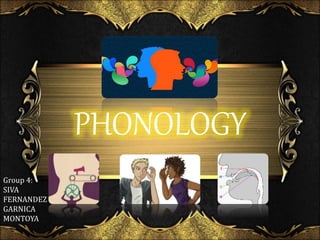
PHONOLOGY.pptx
- 2. ETYMOLOGY The word phonology comes from Ancient Greek φωνή, phōnḗ, "voice, sound," and the suffix -logy (which is from Greek λόγος, lógos, "word, speech, subject of discussion").
- 3. HISTORY In 300 BC, Panini was the first person to study phonology. He created a grammar (a set of language rules) for Sanskrit (an ancient Indian language). He also created a list of the phonemes in Sanskrit. He assigned a symbol to represent each phoneme. The symbols are still used today in phonology.
- 4. HISTORY The first person to use the word "phoneme" was the French linguist Dufriche-Desgenettes. In the 1800s, Jan Baudoin gave the definition of phoneme that is uses today. Soon afterward, Baudouin de Courtenay began the study of phonology.and worked on the theory of phonetic alternations, which predicts changes in the sounds of a language.
- 5. PHONOLOGY It is the study of the sound patterns that occur within languages. It studies how these sounds combine and how they change in combination, as well as which sounds can contrast to produce differences in meaning.
- 6. Phonology tells us what sounds are in a language, how they do and can combine into words, and explains why certain phonetic features are important to identifying a word. • For example,the English plural morpheme has three different pronunciations depending on what noun you attach it to: – It gets pronounced as a [z] for words like cab, bag, and bar – It gets pronounced as [s] for words like cap, back, and faith – It gets pronounced as [əz] for words like bus, garage, and match
- 8. Sound Symbolism It refers to the apparent association between particular sound sequences and particular meanings in speech. Also known as sound-meaningfulness and phonetic symbolism.
- 9. Sound Symbolism Examples: teeny-weeny itsy-bitsy mini and wee A chip sounds smaller than a chop. So do slits compared with slots. Chinks compared to chunks. Dints compared to dents.
- 10. Onomatopoeia An onomatopoeia is a word that sounds like the noise it describes. The spelling and pronunciation of that word is directly influenced by the sound it defines in real life. All onomatopoeia words describe specific sounds. Examples: The buzzing bee flew away. The sack fell into the river with a splash. He looked at the roaring tiger.
- 12. Assimilation A common phonological process by which the sound of the ending of one word blends into the sound of the beginning of the following word. This occurs when the parts of the mouth and vocal cords start to form the beginning sounds of the next word before the last sound has been completed. An example of this would be 'hot potato'. The (t) in 'hot' is dropped as the lips prepare for the (p) sound for 'potato’ .
- 14. Allusion An allusion is a reference or mention of person, event, statement, piece of art, history, myths, religion, or popular culture. The reference is usually indirect within the writing. Since the person, place, or thing is not mentioned directly, it is assumed that the reader already has knowledge of what is being referenced. Therefore, an allusion is when a piece of writing tries to hint at a person, place, thing, literature, or art.
- 17. Alliteration A literary device in which a series of words begin with the same consonant sound. It's used to emphasize something important that a writer or speaker would like to express.
- 19. Stress The relative emphasis that may be given to certain syllables in a word, or to certain words in a phrase or sentence. In English, stressed syllables are louder than non-stressed syllables. Also, they are longer and have a higher pitch.
- 21. Rhythm The sense of movement in speech, which is marked by stress, timing and quantity of syllables. Spoken English words with two or more syllables have different stress and length patterns. The rhythm of English is based on the contrast of stressed and unstressed syllables in regular intervals, with the stresses falling within content words.
- 22. The Rhythm Rule The stressed syllables of the sentence create beats.
- 24. Intonation It describes how the voice rises and falls in speech.
- 25. Falling Intonation This is when the pitch of the voice falls at the end of a sentence. We commonly use them in statements, commands, WH-questions, confirmatory question tags, and exclamations.
- 26. Rising Intonation This is when the pitch of the voice rises at the end of the sentence. It is commonly used in yes or no questions, and question tags that show uncertainty.